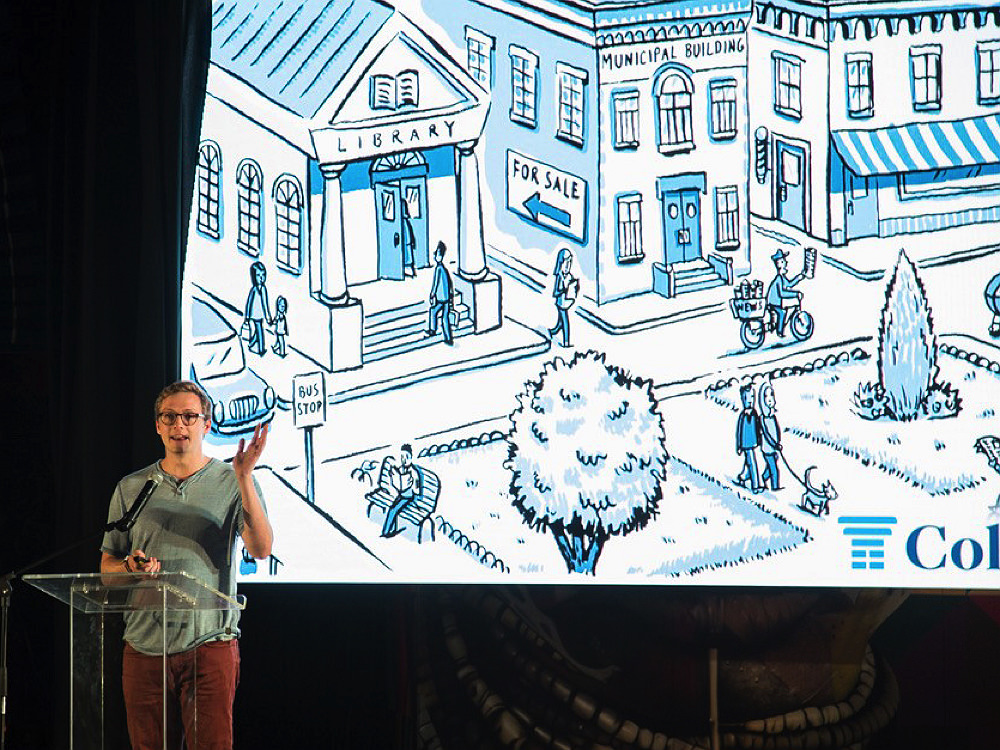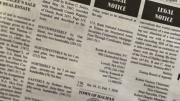Some might doubt that anyone reads those paragraphs of dense text that appear toward the back of the newspaper: the ones that contain information about ordinances, meetings, petitions, foreclosures, municipal budgets, and other official proceedings that governments, businesses, and individuals are legally required to advertise in a local publication.
But these notices are more than a formality. There are people who do, in fact, read them—and who are sometimes inspired to take action. A pharmacist in Ottumwa, Iowa, learned from a notice that the local jail was purchasing medications through CVS at a significant markup; he lobbied for the county to partner directly with a local pharmacy instead. Public notices alerted residents of northwest New Mexico to a drilling company’s petition to increase extraction, allowing them to organize against it. And thousands of people in Newton County, Arkansas, shut down a company’s plan to open a hog farm after it was announced in a public notice.
Stories like these are the primary reason the country’s founders instituted public notices: they wanted informed, engaged citizens. It’s a straightforward principle—but the actual process of publishing public notices is anything but. The back-and-forth of ordering, formatting, scheduling, proofing, billing, and proving for the record that publication has taken place is so laborious and byzantine, in fact, that some states have tried to pass legislation pulling public notices from papers and moving them to in-house websites.
These proposals alarm publications not only because they maintain that allowing governments to publish their own notices undermines trust and accountability, but also because notice fees are a reliable source of income—one that has become a keystone to their business model as advertising revenue declines.

Jake Seaton
Photograph courtesy of Jake Seaton
Enter Jake Seaton ’17, born in Manhattan, Kansas, to a news family that has owned and run the Manhattan Mercury for five generations. In 2015, Seaton dropped out of Harvard to help launch Quorum Analytics—a public-affairs software company—and then returned two years later to finish his computer science degree, all the while devising a way to help keep his family’s business afloat.
His brainchild was Column, a platform that streamlines the process of publishing public notices. Since its launch in fall 2020, the Washington, D.C.-based—but remotely staffed—public-interest corporation has swelled to 15 full-time team members. It boasts partnerships with hundreds of papers—many through deals with large publishers like the Washington Post, The McClatchy Company, Adams Publishing Group, Lee Enterprises, Ogden Newspapers, and Wick Communications—and works with thousands of those papers’ clients in the legal and governmental sectors. As Column approaches its one-year anniversary, it is preparing to open its first post-pandemic office in Miami, where it recently won a startup competition.
On Column’s platform, governments and legal services can draft notices without having to “dig through legal templates” and schedule them without “scouring online for ad deadlines,” according to head of product Annie Schugart ’18. Publishers, meanwhile, can use Column to manage orders, coordinate billing, and create virtual affidavits of publication. (Column is free to publishers and charges governments and legal services a small fee per notice.)
“[Publishing public notices] is a collaborative process that happens between the legal system, the financial sector, banks, the government agencies, the court system, private individuals, and the media,” Seaton said. “What we built is something that connects all of those dots and helps all of them make sure that they’re doing the right things in the right order in a time-efficient way.”
Though the process of publishing public notices requires rejuvenation, its philosophical underpinnings stand the test of time, according to Column chief technology officer Leo Hentschker ’19. It’s “cosmically perfect” that every public notice ends up under the eyes of a journalist, he said: “Especially in a modern context, it seems incredibly forward-leaning.”
By updating the publication process to reflect the modern spirit of public notices—and reducing labor costs for everyone involved—Column thinks it can help this system thrive well into the technological era. Important stakeholders in the journalism world seem to agree: Column counts former executive editor of The Washington Post Martin “Marty” Baron, LL.D. ’21, CEO of the News Media Alliance David Chavern, and former CEO of Gannett Paul Bascobert as part of the extended team. Nancy Gibbs—the director of Harvard’s Shorenstein Center on Media, Politics, and Public Policy and the former editor-in-chief of TIME—serves as its public benefit director.
Seaton said preserving public notices is enough to keep many small papers afloat. “We work with publishers for whom this represents up to 25 percent of their business,” he said. “In a lot of communities, public notice is enough—it is the thing keeping local journalism alive.”
But he also stressed that Column’s mission extends beyond maintaining this revenue stream for local papers: “Column is not a newspaper software company or a ‘saving local news’ company,” he said. “We view our mission as building this really fundamental infrastructure for the public information ecosystem.”
“The scope of Column’s ambition—to improve the utility of public-interest information—is actually staggering when you stop and think about it,” Gibbs said. “It takes a rare blend of imagination and talent to start with a piece of your family’s business and set about building something completely new that will improve a key piece of our democracy.”
As part of its mission, Column also hosts and maintains public-notice databases for 10 states free of charge. The company is organizing all the data it uploads, Seaton said, making it accessible, fast, and searchable.
These centralized databases are a useful supplement—but not a suitable replacement—for notices in papers, he cautioned. “Information shouldn’t just be made passively available on a government website or on a statewide database, but should be actively pushed out to the people,” he said. “All of this [is] really important, impactful stuff that nobody would think about or would actively search out on a website, if it weren't being pushed to them as a public-interest process.”
Of course, the actual reach of small, print publications—especially faltering ones—is debatable. The publisher of BKLYNer and the editor-in-chief of Buzzfeed even argued in the Columbia Journalism Review that public notices are responsible for “the survival of a kind of zombie community print press that soldiers on increasingly without an audience.” They argue that notices should instead appear in online community publications.
Seaton noted that some states are moving toward requiring that notices appear online as well as in print. “The next generation of this policy will still involve the media as the key distributor. Column will help media companies comply with a new patchwork of state regulations that determine the way notices are displayed digitally.”
Seaton stressed that he thinks “it is a very important time for the media industry to be innovating”—especially print publications. Schugart agreed: “Public notice is absolutely one large piece of the puzzle,” she emphasized. “But I think there’s always room for—and needs to be—continued iteration, and innovation.”









